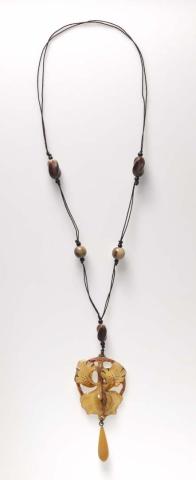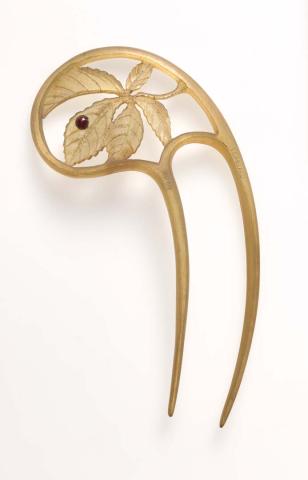Art Nouveau jewellery in the Collection
By Ineke Dane Sophie Rose
Artlines | 3-2023 | September 2023
Editor: Stephanie Kennard
Crafted by French master horn-carver Georges Pierre (1873–1943), Cicada pendant necklace c.1910 and three other delicate examples of Art Nouveau jewellery were recently acquired through the Henry and Amanda Bartlett Trust, greatly enhancing the Gallery’s holdings from this significant period, write Ineke Dane and Sophie Rose.
The shapes and rhythms of nature inspired the style now recognised as Art Nouveau. Less of a unified movement than an aesthetic zeitgeist, Art Nouveau spanned many forms, including architecture, graphic art, luxury objects, fashion and jewellery. This wave of creative output was fruitful but brief, beginning in the 1890s and receding by the 1910s to make way for the more industrialised style of Art Deco. In 1896, designer and architect August Endell wrote:
. . . he who has never been delighted by the exquisite bendings of the blade of grass, by the wonderful inflexibility of the thistle, the austere youthfulness of the sprouting leaf buds . . . and stirred to the depths of his soul, he still knows nothing about the beauty of forms.1
QAGOMA’s growing collection of Art Nouveau objects features several delicately frosted plant, animal and even insect-adorned glass vases by renowned designer and jeweller René Lalique (1860–1945). These vases are complemented by several pieces of horn jewellery that take the form of an orchid pendant, a translucent comb featuring a deciduous leaf, and a dragonfly brooch. Horn jewellery, in particular, reveals the close attention paid by Art Nouveau artists to shapes found in nature, as well as the period’s fascination with Japanese design and new, inexpensive materials.
Cicada pendant necklace c.1910 was crafted by French master horn-carver Georges Pierre, who settled in Oyonnax in the French Alps, which was plentiful in all the necessary materials for artists working in carved horn: buffalo, goat, and fresh water. Here, he shared a studio with Elisabeth Bonté; originally rivals, they ultimately formed a close relationship and worked alongside each other until 1936. By the early twentieth century, their designs were almost indistinguishable, though each retained a separate artistic identity and practice. Pierre had at least three workshops in Paris and appears in several business directories and public records from the time, which also show a factory in Bonneuil and a shop, at 78 rue des Archives, Paris, where he sold bijoux d’art.
Pierre’s Cicada pendant necklace features three of the winged insects. A central cicada is framed by a delicate mandala of ivy leaves, while two further cicadas adorn the cord above. The blue droplet at the base of the pendent suggests the symbolic element of water, completing the overall tableaux vivant by creating a harmony of flora, fauna and base element. Their finely carved detail and delicate colouration demonstrate the deftness with which Pierre worked, and his skill in manipulating horn’s complex material structure.
Horn became a favourite medium, particularly for designers of hairpieces and pendants. Lalique is cited as the first jeweller in Paris to use buffalo horn and praised the material for its modelling ability; this new generation of designers cared less about the distinction between joaillerie (jewellery with precious gems) and bijouterie (which included cheaper materials) — Art Nouveau often dismissed the previously held hierarchies of mediums. More importantly, the relatively inexpensive horn created a new market of middle-class female buyers. In the first decade of the 1900s, French Vogue often celebrated horn for its translucence and adaptability. Many female art students soon took up carving horn and a significant collection of horn jewellery was presented at the Salon in 1908. Amateurs also tried their hand at carving horn and instruction manuals were available for the interested public.2 Carved jewellery and hair adornments were artworks for everyone; in this way, horn encapsulated the loosening of European class relations as the world moved into the twentieth century.
As QAGOMA continues to tell a global history of art and represent the diversity of artists working today, these delicate Art Nouveau objects remind us of an earlier time of cultural exchange: the way Asian art inspired European culture, particularly at the dawn of a new century.
Ineke Dane is Associate Curator, International Art, QAGOMA, and Sophie Rose is former Assistant Curator, International Art, QAGOMA.
Endnotes
- Quoted in Jeremy Howard, Art Nouveau: International and National Styles in Europe, Manchester University Press, Manchester and New York, 1996, p.5.
- Emiel Aardewerk and Esther Aardewerk, Horn Pendants: A Private Collection, trans. Lynne Richards, A. Aardewerk Publishers, The Hague, 2016, p.10.
Connected objects

Libellule brooch early 20th century
- UNKNOWN - Creator


